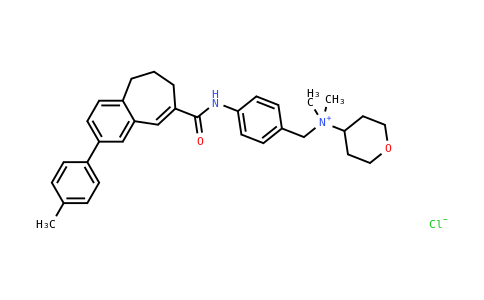1: Baba M, Nishimura O, Kanzaki N, Okamoto M, Sawada H, Iizawa Y, Shiraishi M, Aramaki Y, Okonogi K, Ogawa Y, Meguro K, Fujino M. A small-molecule, nonpeptide CCR5 antagonist with highly potent and selective anti-HIV-1 activity. Proc Natl Acad Sci U S A. 1999 May 11;96(10):5698-703. doi: 10.1073/pnas.96.10.5698. PMID: 10318947; PMCID: PMC21923.
2: De Clercq E. The emerging role of fusion inhibitors in HIV infection. Drugs R D. 1999 Nov;2(5):321-31. doi: 10.2165/00126839-199902050-00010. PMID: 10728472.
3: Dragic T, Trkola A, Thompson DA, Cormier EG, Kajumo FA, Maxwell E, Lin SW, Ying W, Smith SO, Sakmar TP, Moore JP. A binding pocket for a small molecule inhibitor of HIV-1 entry within the transmembrane helices of CCR5. Proc Natl Acad Sci U S A. 2000 May 9;97(10):5639-44. doi: 10.1073/pnas.090576697. PMID: 10779565; PMCID: PMC25881.
4: Shiraishi M, Aramaki Y, Seto M, Imoto H, Nishikawa Y, Kanzaki N, Okamoto M, Sawada H, Nishimura O, Baba M, Fujino M. Discovery of novel, potent, and selective small-molecule CCR5 antagonists as anti-HIV-1 agents: synthesis and biological evaluation of anilide derivatives with a quaternary ammonium moiety. J Med Chem. 2000 May 18;43(10):2049-63. doi: 10.1021/jm9906264. PMID: 10821717.
5: Zhang Y, Lou B, Lal RB, Gettie A, Marx PA, Moore JP. Use of inhibitors to evaluate coreceptor usage by simian and simian/human immunodeficiency viruses and human immunodeficiency virus type 2 in primary cells. J Virol. 2000 Aug;74(15):6893-910. doi: 10.1128/jvi.74.15.6893-6910.2000. PMID: 10888629; PMCID: PMC112207.
6: Baba M, Miyake H, Okamoto M, Iizawa Y, Okonogi K. Establishment of a CCR5-expressing T-lymphoblastoid cell line highly susceptible to R5 HIV type 1. AIDS Res Hum Retroviruses. 2000 Jul 1;16(10):935-41. doi: 10.1089/08892220050058344. PMID: 10890354.
7: De Clercq E. Novel compounds in preclinical/early clinical development for the treatment of HIV infections. Rev Med Virol. 2000 Jul-Aug;10(4):255-77. doi: 10.1002/1099-1654(200007/08)10:4<255::aid-rmv282>3.0.co;2-6. Erratum in: Rev Med Virol 2000 Sep-Oct;10(5):349. PMID: 10891872.
8: Trkola A, Ketas TJ, Nagashima KA, Zhao L, Cilliers T, Morris L, Moore JP, Maddon PJ, Olson WC. Potent, broad-spectrum inhibition of human immunodeficiency virus type 1 by the CCR5 monoclonal antibody PRO 140. J Virol. 2001 Jan;75(2):579-88. doi: 10.1128/JVI.75.2.579-588.2001. PMID: 11134270; PMCID: PMC113953.
9: Spenlehauer C, Gordon CA, Trkola A, Moore JP. A luciferase-reporter gene- expressing T-cell line facilitates neutralization and drug-sensitivity assays that use either R5 or X4 strains of human immunodeficiency virus type 1. Virology. 2001 Feb 15;280(2):292-300. doi: 10.1006/viro.2000.0780. PMID: 11162843.
10: Cormier EG, Tran DN, Yukhayeva L, Olson WC, Dragic T. Mapping the determinants of the CCR5 amino-terminal sulfopeptide interaction with soluble human immunodeficiency virus type 1 gp120-CD4 complexes. J Virol. 2001 Jun;75(12):5541-9. doi: 10.1128/JVI.75.12.5541-5549.2001. PMID: 11356961; PMCID: PMC114266.
11: Huang XQ, Jiang HL, Luo XM, Chen KX, Ji RY, Cao Y, Pei G. Building three- dimensional structures of HIV-1 coreceptor CCR5 and its interaction with antagonist TAK779 by comparative molecular modeling. Acta Pharmacol Sin. 2000 Jun;21(6):521-8. PMID: 11360686.
12: Kanbara K, Sato S, Tanuma J, Tamamura H, Gotoh K, Yoshimori M, Kanamoto T, Kitano M, Fujii N, Nakashima H. Biological and genetic characterization of a human immunodeficiency virus strain resistant to CXCR4 antagonist T134. AIDS Res Hum Retroviruses. 2001 May 1;17(7):615-22. doi: 10.1089/088922201300119716. PMID: 11375057.
13: De Clercq E. New developments in anti-HIV chemotherapy. Curr Med Chem. 2001 Nov;8(13):1543-72. doi: 10.2174/0929867013371842. PMID: 11562282.
14: Esté JA. TAK-779 (Takeda). Curr Opin Investig Drugs. 2001 Mar;2(3):354-6. PMID: 11575704.
15: Gorry PR, Bristol G, Zack JA, Ritola K, Swanstrom R, Birch CJ, Bell JE, Bannert N, Crawford K, Wang H, Schols D, De Clercq E, Kunstman K, Wolinsky SM, Gabuzda D. Macrophage tropism of human immunodeficiency virus type 1 isolates from brain and lymphoid tissues predicts neurotropism independent of coreceptor specificity. J Virol. 2001 Nov;75(21):10073-89. doi: 10.1128/JVI.75.21.10073-10089.2001. PMID: 11581376; PMCID: PMC114582.
16: De Clercq E, Schols D. Inhibition of HIV infection by CXCR4 and CCR5 chemokine receptor antagonists. Antivir Chem Chemother. 2001;12 Suppl 1:19-31. PMID: 11594685.
17: Bannert N, Farzan M, Friend DS, Ochi H, Price KS, Sodroski J, Boyce JA. Human Mast cell progenitors can be infected by macrophagetropic human immunodeficiency virus type 1 and retain virus with maturation in vitro. J Virol. 2001 Nov;75(22):10808-14. doi: 10.1128/JVI.75.22.10808-10814.2001. PMID: 11602722; PMCID: PMC114662.
18: Takashima K, Miyake H, Furuta RA, Fujisawa JI, Iizawa Y, Kanzaki N, Shiraishi M, Okonogi K, Baba M. Inhibitory effects of small-molecule CCR5 antagonists on human immunodeficiency virus type 1 envelope-mediated membrane fusion and viral replication. Antimicrob Agents Chemother. 2001 Dec;45(12):3538-43. doi: 10.1128/AAC.45.12.3538-3543.2001. PMID: 11709336; PMCID: PMC90865.
19: Brelot A, Alizon M. HIV-1 entry and how to block it. AIDS. 2001;15 Suppl 5:S3-11. doi: 10.1097/00002030-200100005-00002. PMID: 11816172.
20: Gorry PR, Taylor J, Holm GH, Mehle A, Morgan T, Cayabyab M, Farzan M, Wang H, Bell JE, Kunstman K, Moore JP, Wolinsky SM, Gabuzda D. Increased CCR5 affinity and reduced CCR5/CD4 dependence of a neurovirulent primary human immunodeficiency virus type 1 isolate. J Virol. 2002 Jun;76(12):6277-92. doi: 10.1128/jvi.76.12.6277-6292.2002. PMID: 12021361; PMCID: PMC136234.
17920529.

